2022 Annual Meeting
(511d) Hydrodynamics Characterisation in a Three-Phase Flotation System Using Positron Emission Particle Tracking (PEPT)
Authors
Diego Mesa, Imperial College London
Katie Cole, University of Cape Town
Michael R. van Heerden, University of Cape Town
Impellers play a key role in flotation cells, as the turbulence generated through agitation aids particle suspension, air dispersion and particleâbubble collision. It is therefore important to understand the effect that different impeller designs have on flotation hydrodynamics, as small variations can enhance flotation performance. The study of flotation hydrodynamics is, however, a complex task due to the opaque, multiphase, and polydisperse nature of flotation systems. In this work, the impact of impeller design modifications on the hydrodynamics of a three-phase flotation cell is quantified for the first time. Two different impeller designs, with and without a stator, were assessed using positron emission particle tracking (PEPT), a technique that allows the position and velocity of radioactive particle tracers within an opaque vessel to be determined. A novel PEPT data analysis strategy, supported by a statistical analysis on the basis of the JensenâShannon distance, facilitated the comparison of the different designs, allowing a robust quantification of their hydrodynamic differences. The experimental results show that the stator significantly modified the hydrodynamics within the flotation cell, distorting the lower mixing loop that is characteristic of radial impellers. The use of a stator also resulted in the reduction of particle velocity and swirling outside of the impellerâstator region, both at the level of the impeller and, notably, at the pulpâfroth interface. These findings have important implications for impellerâstator design, and highlight the effect of the impeller on the hydrodynamics of the pulp and froth phase in flotation systems.


